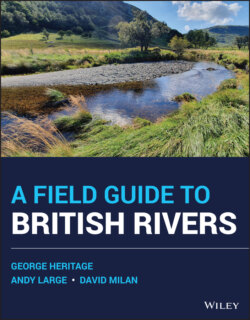Читать книгу A Field Guide to British Rivers - George Heritage - Страница 17
2.2 Classification
ОглавлениеRiver and floodplain systems exist on a continuum between bedrock and fully alluvial states resulting in a myriad of forms across the world. Many river classification systems have been developed to try to categorise watercourse types; initial attempts were primarily based on planform pattern. Straight, sinuous (often referred to as meandering), and braided patterns were distinguished by Leopold and Wolman (1957), and this typology was strongly linked to the slope‐discharge character identified at the same time by Lane (1957). This tripartite division for alluvial rivers has since been further developed, and Church and Rood (1983) provided an excellent précis of this research, extending to many other channel types. It was not until the early 1990s however, that the first combined river and floodplain classification was published (Nanson and Croke 1992) recognising the interlinked functionality of these two components of the wider system.
Despite these earlier research efforts, it often remains difficult to specifically categorise a watercourse. Rosgen (1994) noted this when matching observed characteristics to that anticipated from theory and how this poses significant problems when trying to understand and manage our river systems, while Kondolf and Downs (1996) have criticised regional classifications as providing little link to, or understanding of, river processes, river condition, or potential change trajectories.
Increasingly, the understanding of river and floodplain systems from a morphological perspective has facilitated development of hierarchical classification systems (e.g. Newson 1992; Montgomery and Buffington 1993; Sear 1994; Brierley 1999). In common these classifications impart heightened understanding of the interaction between the physical template of a system, dominant processes, and the ecosystems which develop as a result of these (Newson 1992; Maddock 1999). The knowledge that river form and process both interact and evolve simultaneously means that a functional classification system linked to channel morphology allows the user to predict behaviour from appearance, forecast the magnitude and directional nature of driving hydraulic and sediment controls, provide a frame of reference against which to judge degraded systems, and develop a common framework for understanding rivers.
